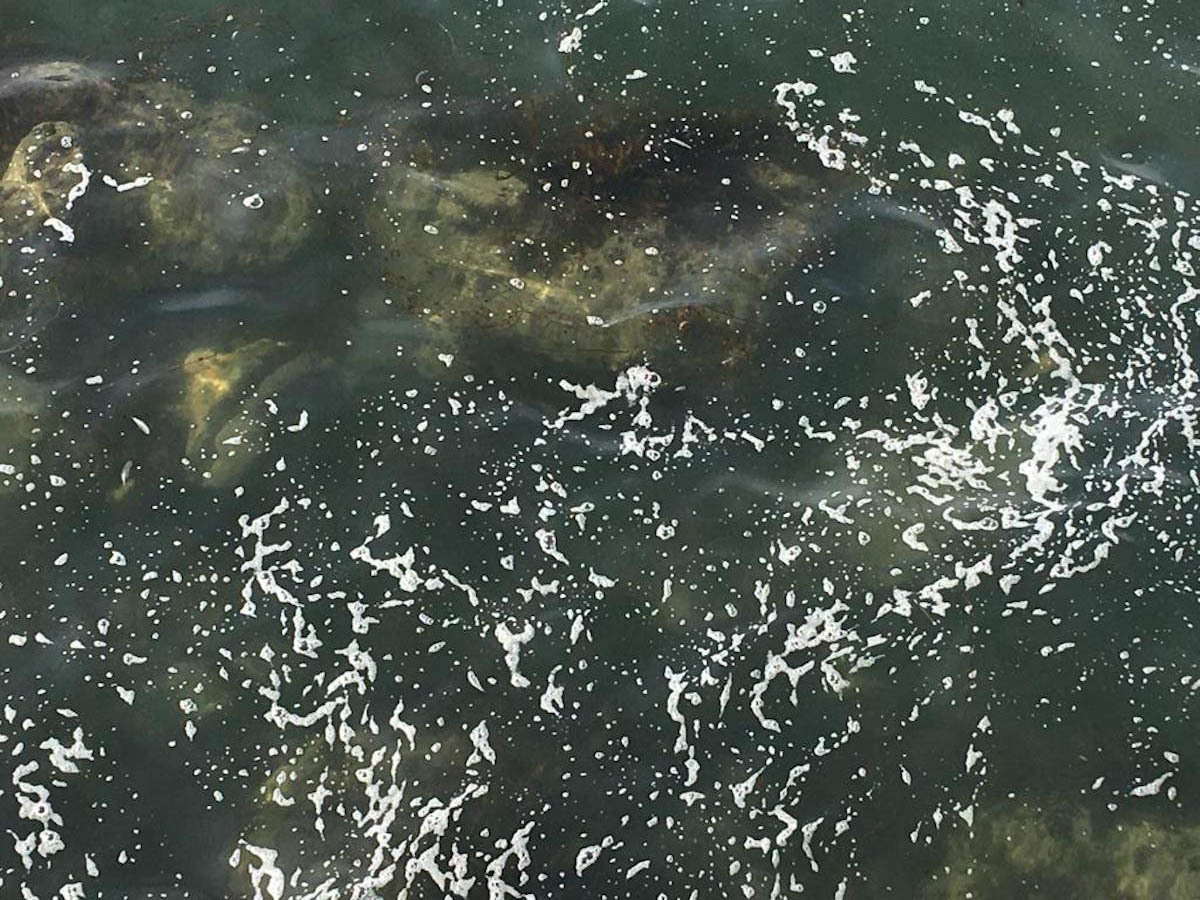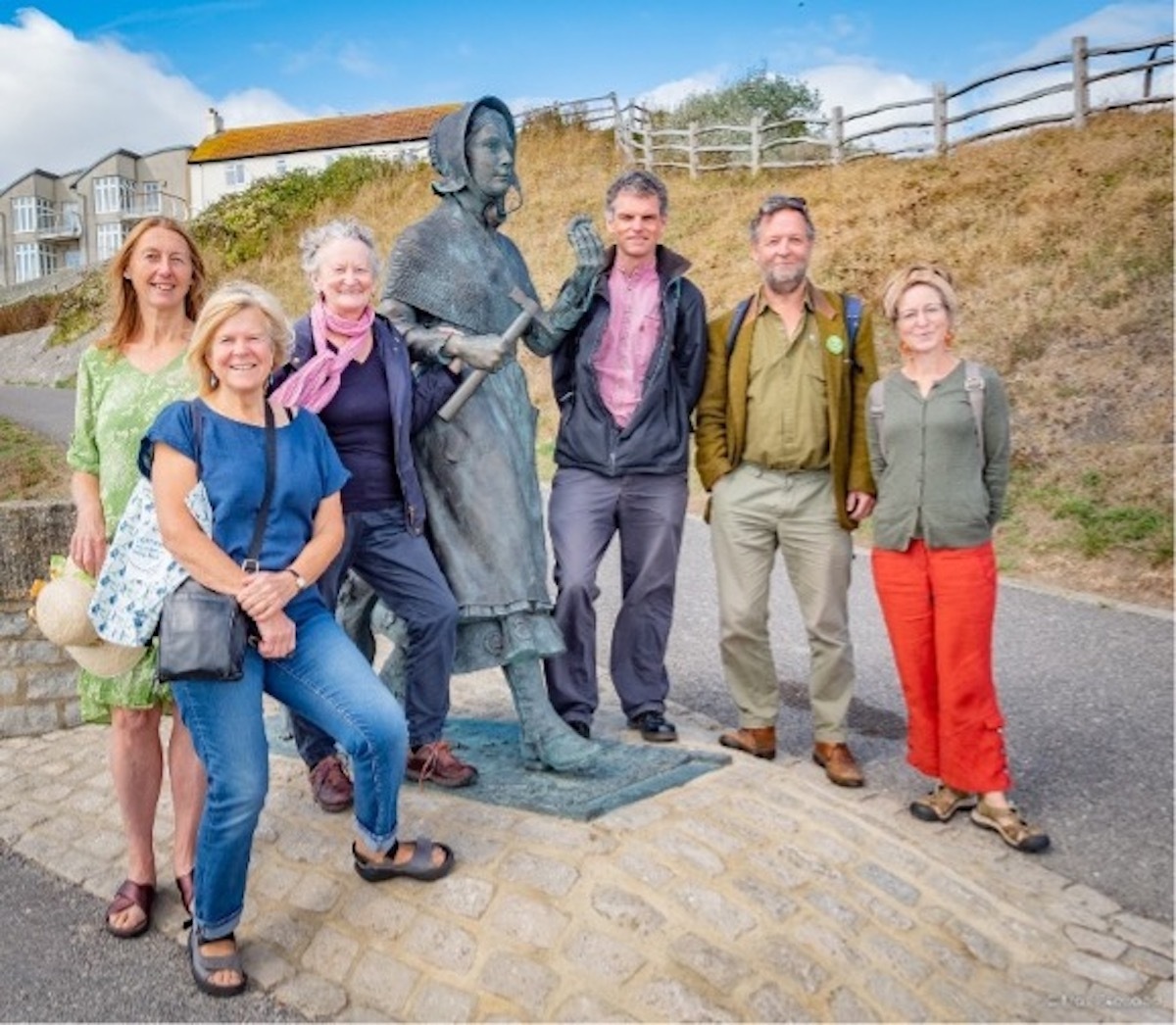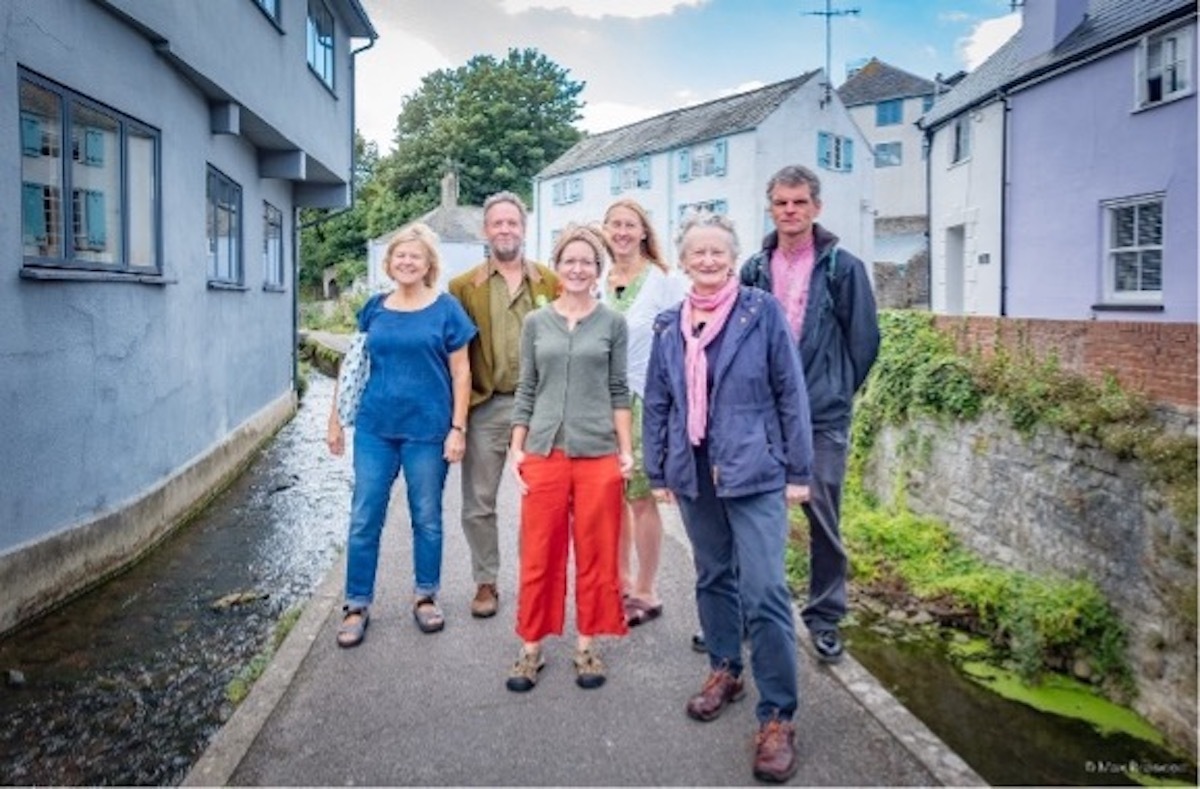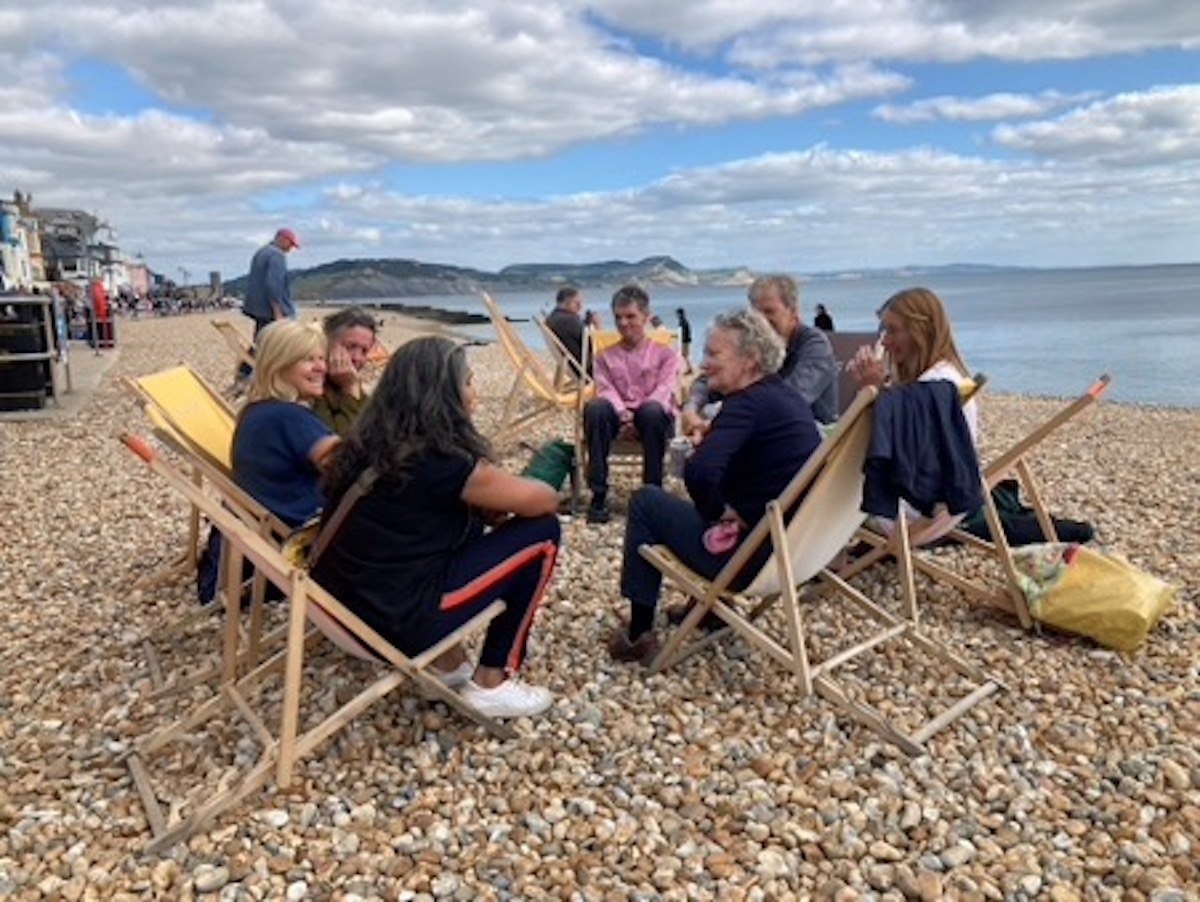
Sewage discharges have been in the news across the country and beautiful Charmouth and Lyme Regis have also been affected. But we are not alone in our efforts to combat this scourge.
Baroness Jenny Jones of Moulsecoomb, one of two peers representing the Green Party in the House of Lords, visited Lyme Regis on Thursday 15 September to meet recently elected Green Party Dorset councillor, Belinda Bawden, to hear about the local volunteer effort to combat the sewage discharges affecting the rivers and beaches in Lyme and Charmouth.
Jenny saw Lyme Regis at its best. Arriving by bus, she found a not-too-busy seaside town on a beautiful early autumn day, the sea speckled with swimmers and paddlers and children playing happily on the beach. But despite appearances, her visit coincided with bacterial contamination at the bathing beach – with the Environment Agency’s weekly monitoring revealing a surge in the intestinal enterococci bacteria. This is one of two pollutants that the Environment Agency looks for. It’s important because, as the Agency says:
“The presence of the bacteria indicates that human or animal faeces may be present in bathing water alongside other potentially harmful organisms that could cause illness”.

Jenny has been campaigning for some time against the disgraceful discharge of untreated sewage by water companies into our rivers and seas. Her visit to Lyme Regis was an opportunity to meet local ‘Citizen Scientists’ from the River Char Community Project, the River Lim Monitors and the Lower Char Community Project. They explained how regular year-round river monitoring allows pollution problems to be identified and how river groups, liaising with water companies, the Environment Agency and local politicians are campaigning for improvements to protect our rivers, our health and our local economy. All three projects are developing wider interest in their communities as the public becomes increasingly aware of our national sewage crisis.
Overlooking Church Cliff Beach, Belinda explained to Jenny how unacceptable the sewage discharges in the River Lim were for Lyme Regis and how locals and visitors alike were affected by the smells, the illnesses and the lack of confidence that our waters are actually safe. The River Lim monitors of Turn Lyme Green were working closely with South West Water (SWW) and the Environment Agency (EA) to investigate where sewage problems were reported, as the beaches were also badly affected, as well as the river. The group is campaigning to have Church Cliff Beach redesignated as a bathing beach so it will once again be regularly monitored and tested for pollution by the Environment Agency.
Belinda said the River Lim ‘Citizen Scientists’ represented a genuine community effort, since the testing kits provided by the West Country Rivers Trust were paid for by the town council. Also, ‘Clean Rivers and Beaches’ had proved the most important issue for people taking part in the 2030 Vision community consultation.
Jenny also spoke to Andrew Carey, a Char Valley Parish councillor from Charmouth, who explained the problems are very different in upper and lower parts of their River Char. Up the river, septic tanks and agricultural management methods are the main problems whereas lower down it is the sewage discharges by Wessex Water.
Andrew highlighted one of the main problems was the bio-beads which are used at the Uplyme sewage treatment plant. He related how members of the monitoring groups had found the same bio-beads scattered all over the ground there on a recent visit, which SWW initially denied. At the meeting, Dana Assinder of the Lower Char Community Project confirmed they were identical to the bio-beads found at the mouth of the River Char and emphasised the hazards of these toxic plastic pellets entering the marine food chain.
The river monitors are now pushing for SWW to clean up their treatment works and fund removal of the washed-up beads from Charmouth beach. Wessex Water, which is responsible for the River Char catchment, does not use bio-beads in its sewage treatment plants on the south coast.
When the group walked up the River Lim, Jenny asked Dana whether local rivers were as clean as they look. Dana explained the importance of chemical and biological testing. She said the Lower Char Community Project currently tests for phosphates and nitrates and soon hopes to measure E. coli, which is a serious hazard and a likely cause of some of the illnesses that swimmers have been reporting. She explained there is an environmental health warning sign at Charmouth telling people not to splash river water near their face and to wash their hands afterwards. She described how the Community Project was working with Wessex Water to find ways to reduce the number of times that untreated sewage is released into the River Char and into the sea at Charmouth Beach every year.

Turn Lyme Green’s River Lim monitoring group was represented by Liz Davis who explained to Jenny that some of the volunteers had recently visited the Uplyme Sewage Treatment Works with a set of questions. South West Water and the Environment Agency conducted a tour, explained the processes and walked the River Lim with the group so the monitors could point out the stretches worst affected by algal bloom and raw sewage.
Liz said that following this meeting and repeated reports by the group of sewage discharges at Woodmead bridge, South West Water appear to have investigated and identified one source of the problem.
Liz explained that a local ecologist had measured the life in the River Lim and found it to be essentially dead below the sewage treatment plant, with very little wildlife except the odd fish and a few dippers. Jenny expressed shock that the whole ecology of plants and microorganisms had gone.
Local retired freshwater ecologist, Graham Roberts was unable to join the meeting but commented in advance that:
“The main issue we want to determine, in my view, is simply why the River is particularly polluted below the known discharge points linked with SW Water sewerage works.
“There is no doubt something bad is happening and this will be impacting upon the water quality for swimmers using Lyme Regis beaches.”
Liz also impressed upon Jenny the need for new planning and building regulations to ensure storm water and sewage are separated at source and that the drainage infrastructure can support extra housing as well as additional summer visitors. The hope is that as the pollution recedes, life will begin to return to the River Lim.
Jenny expressed her support and admiration for their successful grass roots action and will carry on campaigning on the issue of sewage pollution of rivers and beaches. Many in the House of Lords are disturbed by the problem and tried to put a timetable and a plan for the water companies, but it was rejected.
As we gathered on the Town Beach at the end of Jenny’s visit, Sonia Rai, representing the Lyme Regis Bluetit Swimmers joined the group, alongside Green Party town councillor, Rob Smith.

Sonia emphasised the great enthusiasm for, and benefits of, sea swimming throughout the year. She repeated that the quality of the river and sea water must be safeguarded and continuous monitoring, with alerts when sewage has been discharged, are a public health necessity. The local swimmers were grateful for the river monitoring group efforts and would welcome year-round water monitoring at the beach also. Sonia mentioned that many local families were either on or in the water throughout the year, via the sailing club and gig rowing club, and of course by year-round swimming that has exploded in the bay since Covid-19 lockdown.
Everyone agreed with Jenny’s resounding call to “Clean up our rivers and our beaches”, which can only have a positive effect on our community’s health and wellbeing. For a holiday area, the impacts on the economy of a regenerated and thriving environment, teeming with life in all its diversity, are particularly enticing.
It would surely be a win-win achievement.
Baroness Jenny Jones on cleaning up our rivers and beaches: Lyme Regis and Charmouth





